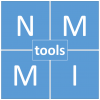AMIDE stands for “Amide’s a Medical Image Data Examiner”. The package is a completely free tool for viewing, analyzing, and registering volumetric medical imaging data sets. It has been written on top of GTK+, and runs on any system that supports this toolkit (Linux, Windows, Mac OS X, etc.).
The main features of the package are listed below:
- Arbitrary orientation, thickness, and time period slice viewing of a data set.
- Thick slabs can be generated by averaging (MPR), taking the maximum (MIP), or the minimum (MIP).
- Multiple data sets can be loaded and viewed at once, with either linked or fused views. Each data set can be viewed from any orientation. Fusing can be done by blending or overlay.
- Nearest Neighbor and Trilinear interpolation functions
- Zooming
- The following color maps are supported: Black/White,White/Black, Red/Green/Blue Temperature, Hot Metal/Blue/Green, Spectrum, NIH/UCLA
- Thresholding: data sets are thresholded independently. Data sets can be thresholded over the entire data set or over each slice.
- 3-dimensional ROI’s can be drawn directly on the images and statistics can be generated for these ROI’s. Currently supported ROI’s are ellipsoids, elliptic cylinder’s, boxes, and isocontours.
- Imports raw data files (8bit, 16bit, 32bit, float, etc.). Also imports Acr/Nema 2.0, Analyze (SPM), DICOM 3.0, InterFile3.3, ECAT 6/7, and Gif87a/89a (using the (X)medcon/libmdc).
- Imports most clinical DICOM files (using the DCMTK library).
- Allows cropping and clearing regions of data sets.
- Anisotropic filtering wizard. Current filters: Gaussian, 1D Median, and 3D Median
- Saves studies (ROI and Data Set data) as XML data.
- Series of slices can be viewed.
- Fly through movies can be generated as MPEG1 files
- True volume rendering support with the capability of rendering multiple data sets at a time. Series of renderings can be saved as MPEG1 movies. Data sets can also be rendered as stereoscopic image pairs
- Alignment of data sets is supported using fiducial markers. This is done by placing fiducial reference points on the data sets to be aligned, and then running an alignment wizard to perform a rigid body transformation (procrustes method).
- A profile tool is included that can calculate Gaussian fits and FWHM’s of the generated line profiles. Profiles can also be saved for external use.
Source Code: Packages, Source Files, Branches, Summary
Tutorials: Documentation Index, User’s Guide in English by Andy Loening, User’s Guide in Spanish translation by Pablo Sau (CDMEDICS PACS WEB), Wiki, FAQs, API reference, Output Examples, Sample Data Sets, Tutorial on 3D Rendering (by Ezekiel Tan)
Reference Papers: Main paper & Postprint


